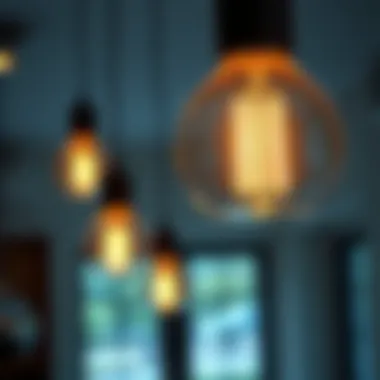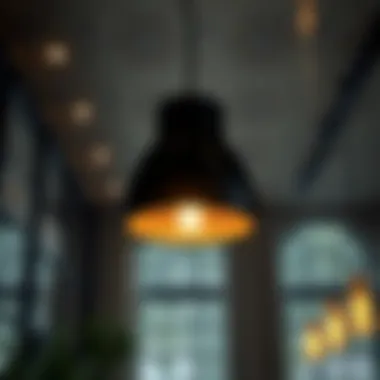The Role of Battery-Powered Pendant Lamps in Modern Interiors


Intro
In today's fast-paced world, lighting isn't just functional; it's a reflection of style and creativity. Battery-powered pendant lamps are emerging as a game changer in modern interiors, providing flexibility and aesthetic appeal that traditional wired lighting can’t match. These lamps serve a dual purpose: they illuminate spaces effectively while adding an element of sophistication to various design schemes. Homeowners, designers, and DIY enthusiasts alike are increasingly turning to these innovative solutions to breathe new life into their environments.
As we delve deeper into the impact of battery-powered pendant lamps, we’ll explore their evolution from rudimentary designs to sleek, contemporary fixtures. We’ll look at how these lamps harmonize with distinct architectural features and help to define spaces within the home—be it in the kitchen, living areas, or cozy nooks.
Additionally, the narrative around modern lighting designs has shifted toward sustainability and energy efficiency. These battery-operated solutions often trump their wired counterparts in reducing electricity consumption, thus appealing to environmentally conscious consumers. Let's flick the switch and illuminate the key aspects of battery-powered pendant lamps and their widespread influence on interior design.
Prolusion
Battery-powered pendant lamps are more than just trendy lighting solutions; they've become a fundamental aspect of modern interior design. With the shift toward minimalistic and functional aesthetics, these lamps offer an innovative approach to illuminating spaces. They are particularly relevant in today’s world, where mobility and versatility often dictate design choices. The ability to move and adapt lighting fixtures according to needs enhances both aesthetic and functional aspects in various settings.
One of the significant reasons for their growing popularity is the freedom they provide. Imagine having the flexibility to place a light fixture anywhere without the constraints of cords and outlets. This quality not only spurs creativity in arranging spaces but also answers the needs of unique layouts in contemporary homes. Moreover, battery-operated lamps are a boon for renters or those looking to retrofit older buildings where installing traditional wiring could be a hassle or not an option at all.
In this article, we explore several aspects of battery-powered pendant lamps. From understanding how these technologies work to discussing their design versatility, practical applications, and environmental implications, each section is designed to provide insights into incorporating these innovative lights into any atmosphere. Throughout the upcoming sections, key benefits such as portability, energy efficiency, and ease of installation will be highlighted, showcasing why they can be a game-changer in interior decor.
"The best lighting can transform a space, making it feel warmer, more welcoming, and strikingly beautiful."
The exploration of battery-powered pendant lamps not only serves design enthusiasts but also homeowners looking for ways to enhance their living spaces affordably and stylishly. As you read through, you will discover how these powerful yet understated devices can redefine any room, making them an essential consideration in modern interior design.
Understanding Battery-Powered Lamp Technology
In the arena of modern lighting solutions, understanding battery-powered lamp technology is like having the blueprint to a city. It opens doors to versatility and a fresh approach to illumination in our spaces. As we delve into this subject, we see not just the mechanics of battery use but also its impact on design, functionality, and sustainability. In recent years, such lamps have taken center stage. With a blend of convenience and charm, they have swiftly become the go-to option for anyone looking to enhance their decor while also reaping the rewards of energy-savvy choices.
Historical Development
The journey of battery-powered lamps traces back to the early 20th century. It's intriguing to realize how this technology has evolved. Initially, these lamps were only a mere experiment — a flicker of what would become a revolution in the lighting industry. Early models lacked the reliability and efficiency we see today, but they laid the groundwork for future innovations. Over time, as battery technology matured, the designs improved dramatically, leading to a boom in portable lighting options.
Current Battery Technologies
In today’s world, several battery technologies are crucial for powering pendant lamps. Let's break them down:
Lithium-Ion
Lithium-ion batteries are a big deal. Their light weight and high energy density make them a favored choice in battery-powered pendant lamps. They hold a charge for extended periods without needing frequent replacement. A particularly attractive feature is their ability to undergo numerous charge cycles while losing minimal capacity. This efficiency translates to a longer lifespan for lamps. However, it's essential to be wary of the environmental concerns revolving around lithium extraction and disposal practices.
Nickel-Metal Hydride
Another contender is the Nickel-Metal Hydride battery, an alternative that's often seen in household gadgets. Though it lacks the longevity of lithium-ion, it’s still a popular choice due to its performance in high-drain devices. These batteries are generally less toxic and easier to recycle, making them a more environmentally friendly option. However, they do have a higher self-discharge rate, meaning they lose charge faster when not in use compared to lithium-ion batteries.
Solar Options
Enter solar options. Harnessing the sun’s energy is what makes these batteries stand out. As such, they align perfectly with the growing trends toward sustainability and off-grid living. Charging battery-powered lamps through solar energy means you can place them in areas with no electrical outlets. On the flip side, they might not provide the same power output consistently as their wired counterparts, especially on cloudy days.
Advantages Over Traditional Lighting
Portability
Portability is a strong selling point. Imagine not being tied down by wires; that’s the allure of battery-powered lamps. You can move them about as you please, creating a flexible arrangement in any space. Whether it’s a reading nook or backyard gathering, their lightweight design means you can light up wherever you find yourself.
Energy Efficiency
Battery-powered lamps often outshine their traditional counterparts in terms of energy efficiency. With lower energy consumption, they cut down on electricity bills. This not only benefits the wallet but also contributes to a reduced carbon footprint, an important consideration for eco-conscious homeowners.
Ease of Installation
When it comes to installation, they’re a dream come true. Forget about needing an electrician to handle complex wiring; these lights can usually be set up within minutes, requiring little more than a stable surface to rest upon. It makes redecorating or refreshing a room less daunting since there's no need for an invasive setup process.
In summation, battery-powered lamp technology reshapes our perception of lighting in contemporary spaces. By grasping the underlying mechanics and the choices at our disposal, homeowners, designers, and enthusiasts open avenues for creativity and practicality that wasn't readily available before.
Design Versatility of Pendant Lights


The adaptability of pendant lights in modern interiors stands out significantly. Battery-powered options offer unmatched flexibility that can elevate ambiance while catering to various design aesthetics. Beyond mere functionality, these fixtures also provide a canvas for creativity. The way a pendant light can transform a space—from cozy to contemporary—is remarkable.
Style Variations
Modern
Modern pendant lamps shine brightly in today's interior landscape. Their sleek lines and minimalistic design aim to project a sense of sophistication. Adding modern lights to a setting enhances the room's appeal with an effortlessly chic vibe. Another striking feature is their cropped silhouettes, which often combine various materials. This unique blend enables them to absorb ambient light, creating a delightful atmosphere.
However, one might argue that their minimalist nature can sometimes feel stark or impersonal, especially in spaces aiming for warmth and character. Therefore, it’s essential to strike a balance when choosing modern options while keeping the space inviting.
Industrial
Industrial-style pendant lamps have carved a niche for themselves. Their raw look—often featuring metal and exposed bulbs—adds an edgy touch to any room. These designs pay homage to repurposed factories and warehouses, creating an element of nostalgia while being trendy and practical. Their robust materials make them highly durable, catering to high-traffic areas, altering spaces from bland to statement-making.
Yet, potential downsides include their heavier visual weight, which might overshadow delicate designs in smaller rooms. Pairing industrial lights with softer elements can help maintain visual interest without overpowering other decorative choices.
Vintage
Vintage styles deliver a touch of history to modern interiors. These lamps evoke memories of simpler times, often featuring ornate details and cozy, warm light. This wears a rich patina, radiating charm and nostalgia. They can turn any space into a conversation piece, inviting people to take a moment to appreciate the character held within the design.
On the flip side, vintage fixtures might clash with more contemporary decor, making it crucial to ensure they complement surrounding elements. Proper placement is vital to avoid creating a visual discord that detracts from the overall design intention.
Color and Materials
Metals
Choosing metal pendant lights brings a modern edge with a touch of industrial flair. Notable for their durability, metal fixtures can stand the test of time, enduring wear and tear. Their reflective surfaces can enhance the light quality in a room, making spaces feel more expansive. Colors—from classic brass to sleek chrome—enable various fitting styles, allowing homeowners to tailor them to personal tastes.
Nonetheless, metal can sometimes contribute to a cooler atmosphere, which may not work in settings aiming for warmth. Mixing metals can alleviate this issue, creating visual intrigue while blending different styles harmoniously.
Glass
Opting for glass pendant lamps promises sophistication and elegance that’s hard to beat. They not only allow light to travel freely but also come in various textures and tints, playing with how one perceives space. Clear glass can make a room feel airy, while tinted options exude warmth or coolness, depending on the shade.
However, glass can be prone to scratches or breakage, making maintenance a consideration. Regular cleaning is needed to keep the clarity and brilliance intact, especially in high-traffic areas.
Fabric
Fabric pendant lights present a softer alternative that adds warmth and texture to interiors. Available in a myriad of patterns and colors, these fixtures provide an opportunity to display personal style. Soft lighting emitted through fabric can create intimate settings. They often suit dining areas or relaxed lounge spaces, enhancing coziness.
On a downside, fabric can absorb dust and stains, requiring periodic washing or replacing. Hence, they may be less ideal for particularly busy environments, where maintenance frequency cannot keep up with wear.
Overall, the beauty of battery-powered pendant lamps lies in their design versatility, making them not just functional pieces but also focal points in any contemporary interior.
Practical Applications in Interior Design
The utilization of battery-powered pendant lamps within interior design is not merely a trend; it represents a shift in how we think about lighting in our living spaces. These artisanal lamps offer adaptability and creativity that might be missing from fixed lighting solutions. The practical applications are varied and impactful, providing both functional lighting and aesthetic appeal. Homeowners and designers alike are keen to tap into the potential that these versatile fixtures present, especially as they intersect with modern lifestyles that prioritize mobility, sustainability, and style.
Living Spaces
Dining Areas
Dining areas have always served as the heart of the home where meals are shared, stories are told, and laughter fills the air. The flexibility offered by battery-powered pendant lamps makes them an appealing choice for illuminating these spaces. These lamps can be easily repositioned and adjusted according to the occasion, whether it's an intimate dinner or a festive gathering. Their ability to blend seamlessly into various interior themes—be it rustic, contemporary, or eclectic—adds to their charm.
A key characteristic of battery-powered pendant lamps in dining areas is that they provide focused illumination which brings attention to the dining table while creating a warm ambiance around it. Unlike traditional overhead fixtures that may cast shadows or create uneven lighting, these lamps can be positioned to highlight the food and the people at the table. This unique feature fosters a more inviting and engaging dining experience.
However, one should be cautious about the battery replacement frequency. While the initial attraction is strong, homeowners must consider the maintenance needed to keep the lights in good working condition to avoid any disruption during special occasions.
Lounge Spaces
When it comes to creating a cozy and inviting atmosphere, lounge spaces are where battery-powered pendant lamps truly shine. These lamps add a soft glow that can transform a stark corner into an inviting nook. Given their portable nature, they can be moved around or even taken outdoors for gatherings, providing versatility that fixed lighting often lacks.
A standout characteristic of using these lamps in lounge settings is their ability to create mood lighting. Options are plentiful; dimmed settings can induce relaxation, while brighter levels can uplift and energize the space. Pendant lamps, given their suspension and design, also serve as artistic decor elements that elevate the overall theme of the lounge, be it minimalist, bohemian, or mid-century.


Yet, potential downsides exist. Some users may find the need for regular charging a minor inconvenience, especially during lengthy gatherings. Nonetheless, the appeal remains strong due to the transformative power these lamps have to enhance social interactions and comfort in lounge areas.
Outdoor Usage
Patios
Patios often serve as an extension of the indoors, where space is meant for relaxation and entertainment. Battery-powered pendant lamps bring life to these outdoor settings, illuminating gatherings long after the sun goes down. One of the benefits of using these lights in patios is their mobility. Homeowners can rearrange furniture, alter the atmosphere, or even change the layout without the constraint of fixed installations.
The key feature of patio lighting is not just functionality but also ambiance creation. The warm, diffuse light of these lamps enhances outdoor aesthetics, adding to the charm of evening meals or socializing beneath the stars. However, there are concerns with weather resistance, as not all battery-powered lamps are built for outdoor environments. Care must be taken to ensure the selected options can withstand outdoor elements without compromising performance.
Gardens
Gardens provide a serene backdrop that becomes magical when enhanced with subtle lighting. Battery-powered pendant lamps offer a unique solution for garden lighting; they can highlight pathways or create focal points among plants and flowers. The ability to attractively illuminate garden spaces extends the usability of outdoor areas, allowing night-time enjoyment which was previously reserved for daytime.
A notable characteristic of gardens illuminated by these lamps is the potential for interactive design. Homeowners can strategize lighting to enhance specific plants or garden features, creating an ever-evolving artwork that blends nature with human creativity. Despite their appeal, one must think about where power is sourced and how often batteries need to be replaced, ensuring that garden aesthetics remain uninterrupted.
In summary, battery-powered pendant lamps not only add functional lighting but also contribute to the essence and character of living spaces. Each setting—be it dining, lounging, patios, or gardens—benefits from the unique qualities these lamps bring, making them an ideal choice in today’s modern interiors.
Environmental Considerations
In the contemporary design landscape, it is increasingly evident that the choices made in lighting not only define aesthetics but also impact our environment significantly. Battery-powered pendant lamps, while adding unique style to interiors, bring along a critical conversation about environmental sustainability. Their usage entails considerations such as the sustainability of battery production and the challenges posed by recycling and electronic waste. Understanding these factors is vital for homeowners, designers, and retailers who aspire to promote eco-friendly lighting solutions without compromising functionality or design.
Sustainability of Battery Production
The production of batteries is a cornerstone of how we assess the environmental footprint of battery-powered lighting. The materials used in batteries, particularly lithium-ion batteries, raise various sustainability concerns. Mining for lithium, cobalt, and nickel — the main components of these batteries — can result in significant habitat destruction and pollution if not managed responsibly. Additionally, the energy used during the extraction and production phases can lead to considerable carbon emissions.
"Electrifying a home shouldn’t come at the expense of our planet. Sustainable practices in battery production are essential for greener interior solutions."
Innovative practices are emerging in the battery industry to combat these environmental impacts. Companies are investing in ethical sourcing strategies and adopting more sustainable mining practices. For example, some have begun exploring recycling methods for battery components and transitioning to methods that reduce energy consumption during production. Homeowners should seek lamps that utilize batteries produced by companies demonstrating strong commitments to sustainability, thus fostering a more responsible approach to interior design.
Recycling and E-Waste
The end of a battery's life prompts another critical issue: recycling and the management of e-waste. Disposing of batteries improperly can lead to toxic pollutants leaching into soil and waterways, creating environmental hazards. This is why proper recycling methods are as crucial as the sustainable production of batteries. Not all batteries are recyclable, and understanding which types can be effectively processed is essential for eco-conscious consumers.
To address the challenges posed by e-waste, many cities and organizations have established battery recycling programs, encouraging users to dispose of their old batteries responsibly. Here’s a list to keep in mind for proper disposal:
- Check local guidelines for battery recycling programs.
- Participate in community recycling drives for electronics and batteries.
- Utilize retailer take-back programs that ensure proper recycling of batteries.
In the pursuit of integrating battery-powered pendant lamps into modern interiors, being aware of the lifecycle of batteries from production to disposal can inform better choices. Consumers can influence manufacturers by supporting brands prioritizing eco-friendly practices. This ongoing dialogue between environmental consideration and modern design will shape the future of how we illuminate our spaces.
Installation and Maintenance
The presence of battery-powered pendant lamps in modern interiors serves not only an aesthetic purpose but also demands attention to installation and maintenance. Having a clear understanding of these aspects not only ensures that the lamps function optimally but also amplifies their overall impact on the space. Poor installation can lead to safety hazards, while neglecting maintenance can diminish their visual appeal over time.
Installation Guidelines
When deciding to install a battery-powered pendant lamp, it's crucial to follow certain guidelines to ensure it not only looks great but also operates safely.
- Choosing the Right Location: First off, the spot where the lamp will hang is vital. Look for places that benefit from additional lighting but are also safe from potential obstacles like furniture. Ideal spots might include over a dining table or in a cozy reading nook.
- Read the Manual: A lot of people underestimate this. Manuals are there for a reason! They often provide insights specific to the model you have chosen. Not all fixtures are created equal, so be sure you are familiar with the specifics, such as weight limitations or mounting instructions.
- Secure the Mounting: Use the right hardware to secure the fixture. If you're hanging the lamp from the ceiling, ensure the ceiling type can hold its weight. Consider using anchors if mounting to drywall to prevent accidents.
- Proper Wiring: If your model requires it, additional attention to wiring is needed. Follow any electrical guidelines properly. If you're ever in doubt, it’s wise to consult a professional.
- Height Matters: The height at which the lamp hangs can dramatically affect the ambiance. Typically, a height of 30 inches above a tabletop works well for dining spaces, but feel free to adjust according to your setup.
Battery Replacement and Care
An often overlooked aspect is the battery maintenance for these lamps. Remember that the use and lifespan of your lamp will be influenced greatly by how you care for the batteries. Consider the following:
- Know Your Battery Type: Be aware of the specific type of battery your pendant lamp uses—whether it's lithium-ion or nickel-metal hydride. Each has different lifespan expectations and replacement needs.
- Monitor Battery Life: A keen eye on battery life allows for timely replacements, ensuring your lamp doesn’t suddenly fail during a special occasion. Some designs may even offer indicators for battery health.
- Store Batteries Properly: If you need to remove batteries for storage, keep them in a cool, dry place. Extreme temperatures might shorten their life.
- Dispose Responsibly: When the time comes for battery replacement, don’t just toss them in the trash. Look for local recycling programs to dispose of them properly, contributing to a sustainable lifestyle.
"Proper maintenance not only prolongs the life of your lamp but also maintains its aesthetic appeal. A well-cared-for fixture can light up your home for years to come."
Assuring implants are well-installed and well-maintained is essential in maximizing their benefits. A good approach will help homeowners, designers, and DIY enthusiasts alike integrate these lamps seamlessly into their spaces.
Trends in Battery-Powered Lighting


The world of interior design is constantly in flux, and the rise of battery-powered lighting has stirred quite an interest among homeowners and designers alike. Understanding these trends is essential to appreciate how they influence the aesthetic and functional elements of modern interiors. Within this context, battery-powered pendant lamps have become more than mere sources of light; they signify a shift in design philosophy, embracing flexibility and sustainability.
Emerging Design Trends
In recent years, designers are leaning towards creating spaces that reflect individuality through unique lighting solutions. Battery-powered pendant lamps offer a canvas for that creativity. The emergence of styles that merge traditional craftsmanship with contemporary touches is becoming more notable. For instance, pendant lamps with handcrafted details paired with sleek, metallic finishes not only light a space but also draw attention. This balance between old and new appeals to a wide audience and allows for personalization in every corner of one’s home.
Designs now often integrate natural materials, showcasing textures that add warmth. Consider wood finishes, which are being paired seamlessly with glass and metal. The resulting designs are not just functional; they provide a focal point in a room. The flexibility of these lamps, which can be moved as needs change, reflects broader trends toward adaptability within our living spaces.
Connectivity Features
Smart Technology
Smart technology has made waves in home design, bringing a new level of convenience and customization. Battery-powered pendant lamps equipped with smart functions allow users to control the lighting atmosphere with ease. This kind of technology typically incorporates features such as wireless connectivity and integration with smart home systems.
A notable characteristic of smart technology is its adaptability. Users can adjust brightness levels or even change colors remotely. This flexibility suits a variety of occasions, whether hosting a dinner or enjoying a quiet evening. However, while this tech offers undeniable ease, some users face challenges with setup and compatibility with existing systems, which may deter potential buyers who prefer simpler solutions.
Remote Control Options
Remote control options provide another layer of convenience that complements battery-powered lamps. Picture this: You’re snuggled up on the couch, and instead of getting up to adjust the lights, a quick press of a button refreshes your space instantly. This capability not only enhances user experience but also contributes to the usability of these lamps, especially in larger rooms or spaces with multiple pendant fixtures.
One key feature of remote control options is the ability to pre-set lighting scenes. Users can create specific moods for different activities, making the lamps versatile companions in any home. However, it’s worth noting that reliance on remotes can backfire if batteries die unexpectedly, leading to frustration. Nevertheless, the benefits still outweigh such inconveniences for many homeowners who value seamless interaction with their lighting.
Battery-powered pendant lamps have transformed from simple lighting solutions to essential elements that redefine spaces, making adaptability and innovation key themes in modern design.
Culmination
In summary, trends in battery-powered lighting, especially pendant lamps, reveal much about the evolving landscape of interior design. From emerging styles that reflect personal taste to cutting-edge connectivity features, these lamps represent a blending of aesthetics and functional design. Keeping abreast of these trends can empower designers and homeowners to make informed decisions that enhance both the beauty and practical use of their spaces.
Evaluating Cost vs. Benefit
The integration of battery-powered pendant lamps into modern interiors raises the essential topic of evaluating cost versus benefit. As homeowners and designers strive to create functional yet aesthetically pleasing spaces, understanding the financial implications of adopting these innovative lighting solutions is crucial. Battery-powered pendant lamps can represent a significant initial investment, yet they also offer a multitude of longer-term savings and efficiencies that can make them a worthwhile consideration for many spaces.
Initial Investment Considerations
When contemplating battery-powered pendant lamps, the initial cost is usually at the forefront of one’s mind. Unlike traditional hard-wired lighting options, battery-powered alternatives often command a premium price due to their advanced technology and versatility. However, here are some factors to consider regarding the initial investment:
- Quality of Materials: Higher-priced units may come with superior materials and craftsmanship, which can significantly enhance durability and overall appearance. Investing early in quality can save costs down the road through reduced need for replacements.
- Battery Technology: Different lamps utilize various battery technologies that can affect upfront costs. For instance, lithium-ion lamps, known for their extended life and higher performance, may cost more initially but offer better efficiency in use.
- Installation Costs: One major advantage of battery-powered lamps is their ease of installation. There’s often no need for rewiring or extensive labor, which can save on contractor fees.
- Design and Adaptability: Many battery-powered pendant lamps feature designs that are versatile. This adaptability allows homeowners to change their lighting fixtures without major renovations, which could be a substantial saving in the long run.
In weighing these initial costs, homeowners should not overlook the potential for unique aesthetics and functionality that these lamps bring to a space.
Long-Term Savings
Once the dust settles on the initial investment, it's time to focus on long-term savings associated with battery-powered pendant lamps. Many often find that these lamps can off-set their initial costs over time. Here’s how:
- Energy Efficiency: Battery-powered lamps, particularly those powered by efficient batteries, can significantly reduce electricity bills compared to traditional options. The savings can add up, especially in homes that have many lights running for extended periods.
- Reduced Maintenance Costs: These fixtures typically require less maintenance than hardwired systems. For instance, with simpler installation methods, they generally need fewer repairs or adjustments over the years, which translates to cost efficiency.
- Sustainability Incentives: Some regions offer energy credits or rebates for using sustainable products, which can help reduce effective costs. These savings can be particularly enticing for environmentally conscious consumers who want to minimize their ecological footprint.
- Longevity of Design: Battery-powered pendant lamps often incorporate modern, timeless designs that can stay relevant for years. This can mean that the lamps won't feel dated, preventing the need for expensive replacements simply because the design is out-of-style.
"Investing in battery-powered pendant lamps is not just about the upfront price tag; it’s about understanding how they can impact your finances long after they’re installed."
By evaluating both the initial costs and the potential long-term savings, homeowners can make educated decisions that align with both their financial goals and their design aspirations. This multitiered approach not only emphasizes the financial logic behind battery-powered pendant lamps but also nurtures a deeper appreciation for their adaptability within the evolving landscape of modern interior design.
Ending
The exploration of battery-powered pendant lamps in modern interiors underscores their multifaceted significance in today's design landscape. As practical and aesthetic solutions, these lamps are carving out a niche that enhances not only the physical appearances of spaces but also their functional capabilities.
One critical element that stands out in this discussion is their environmental impact. The shift toward battery-powered lighting reduces dependency on traditional electrical systems, which can translate into lower energy consumption. This aspect appeals to a growing demographic of eco-conscious consumers striving for sustainability in their homes. Furthermore, advancements in battery technology lead to lamps that boast longer lifespans, thus reducing overall waste and negating concerns about frequent replacements.
Another important factor to consider is design versatility. The vast array of styles available—from sleek modern silhouettes to rustic vintage designs—ensures that homeowners and designers can find lamps that fit their unique aesthetics. This adaptability empowers individuals to express their personal style while simultaneously benefitting from innovative lighting solutions.
In addition to aesthetics, the practical applications of these lamps enhance their value. With their portability, the ability to shift lighting as needed in living areas or outdoor spaces can transform a gathering or a quiet evening into something special. This flexibility means a single lamp can fulfill multiple roles, catering to ever-changing needs and preferences.
Furthermore, the economic considerations are paramount. While the initial investment in quality battery-operated lamps can seem steep, the long-term savings derived from reduced electricity bills and minimal maintenance costs can hardly be overlooked. Homeowners, designers, and DIY enthusiasts alike can appreciate the dual benefit of investing in quality fixtures that pay off over time.
In essence, battery-powered pendant lamps represent a blend of form and function, marrying beautiful design with the trends and technologies of modern living. They are not merely a fleeting trend but rather an influential element that promotes transformative thinking about how we light our spaces. Their relevance in interior design will only grow as technology evolves and sustainability becomes an even bigger focus for both consumers and manufacturers.
"Sustainability and design can go hand in hand; not only do battery-powered lamps illuminate your space, they also light up your eco-friendly lifestyle."
For more information on battery technologies, check out the following resources:















